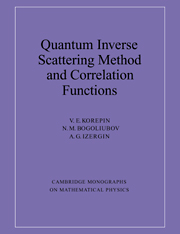Book contents
- Frontmatter
- Contents
- Preface
- Part I The Coordinate Bethe Ansatz
- Introduction to Part I
- I The One-dimensional Bose Gas
- II The One-dimensional Heisenberg Magnet
- III The Massive Thirring Model
- IV The Hubbard Model
- Part II The Quantum Inverse Scattering Method
- Part III The Determinant Representation for Quantum Correlation Functions
- Part IV Differential Equations for Quantum Correlation Functions
- Final Conclusion
- References
- Index
I - The One-dimensional Bose Gas
Published online by Cambridge University Press: 04 August 2010
- Frontmatter
- Contents
- Preface
- Part I The Coordinate Bethe Ansatz
- Introduction to Part I
- I The One-dimensional Bose Gas
- II The One-dimensional Heisenberg Magnet
- III The Massive Thirring Model
- IV The Hubbard Model
- Part II The Quantum Inverse Scattering Method
- Part III The Determinant Representation for Quantum Correlation Functions
- Part IV Differential Equations for Quantum Correlation Functions
- Final Conclusion
- References
- Index
Summary
Introduction
The one-dimensional Bose gas with point-like interaction of the particles (the quantum variant of the nonlinear Schrödinger equation) is one of the main and most important models which can be Solved by means of the Bethe Ansatz. This model has been thoroughly investigated (and. We shall start with the construction of eigenfunctions of the Hamiltonian in a finite volume. Quantities interesting from the physical point of view (in the thermodynamic limit at zero temperature) are considered; the thermodynamics at finite temperatures is investigated in detail as well. A number of essential ideas which will be applied to other models are introduced.
The construction of eigenfunctions of the Hamiltonian is explained in section 1. Their explicit form and, in particular, the two-particle reducibility, are common features of the models solvable by means of the Bethe Ansatz method. Periodic boundary conditions are imposed on the wave function in section 2; the Bethe equations for the particle' momenta are introduced and analyzed. Taken in the logarithmic form, these equations realize the extremum condition of a certain functional, the corresponding action being called the Yang-Yang action. The transition to the thermodynamic limit is considered in section 3. In that same section the ground state of the gas is constructed. The density of the particle distribution in momentum space and the energy of the ground state are calculated. The method of the transition to the thermodynamic limit described in this section is rather general and may be applied to any model solvable by means of the Bethe Ansatz. In section 4, excitations above the ground state are constructed and their main characteristics (energy, momentum and scattering matrix) are determined by means of the dressing equations. The ground state of the model is the Dirac sea (also called the Fermi sphere).
- Type
- Chapter
- Information
- Publisher: Cambridge University PressPrint publication year: 1993
- 1
- Cited by

